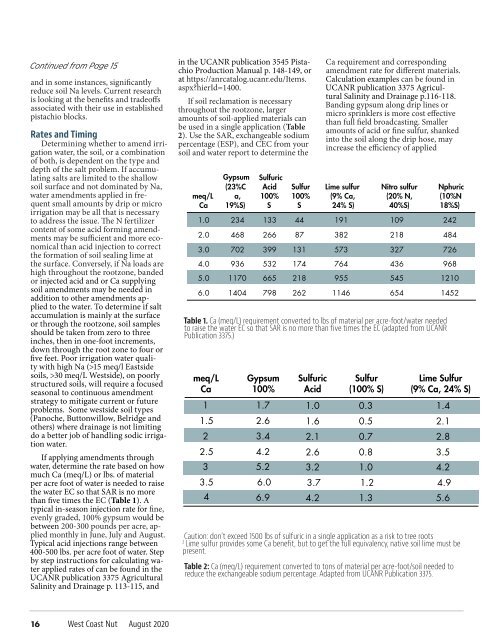Create successful ePaper yourself
Turn your PDF publications into a flip-book with our unique Google optimized e-Paper software.
Continued from Page 15<br />
and in some instances, significantly<br />
reduce soil Na levels. Current research<br />
is looking at the benefits and tradeoffs<br />
associated with their use in established<br />
pistachio blocks.<br />
Rates and Timing<br />
Determining whether to amend irrigation<br />
water, the soil, or a combination<br />
of both, is dependent on the type and<br />
depth of the salt problem. If accumulating<br />
salts are limited to the shallow<br />
soil surface and not dominated by Na,<br />
water amendments applied in frequent<br />
small amounts by drip or micro<br />
irrigation may be all that is necessary<br />
to address the issue. The N fertilizer<br />
content of some acid forming amendments<br />
may be sufficient and more economical<br />
than acid injection to correct<br />
the formation of soil sealing lime at<br />
the surface. Conversely, if Na loads are<br />
high throughout the rootzone, banded<br />
or injected acid and or Ca supplying<br />
soil amendments may be needed in<br />
addition to other amendments applied<br />
to the water. To determine if salt<br />
accumulation is mainly at the surface<br />
or through the rootzone, soil samples<br />
should be taken from zero to three<br />
inches, then in one-foot increments,<br />
down through the root zone to four or<br />
five feet. Poor irrigation water quality<br />
with high Na (>15 meq/l Eastside<br />
soils, >30 meq/L Westside), on poorly<br />
structured soils, will require a focused<br />
seasonal to continuous amendment<br />
strategy to mitigate current or future<br />
problems. Some westside soil types<br />
(Panoche, Buttonwillow, Belridge and<br />
others) where drainage is not limiting<br />
do a better job of handling sodic irrigation<br />
water.<br />
If applying amendments through<br />
water, determine the rate based on how<br />
much Ca (meq/L) or lbs. of material<br />
per acre foot of water is needed to raise<br />
the water EC so that SAR is no more<br />
than five times the EC (Table 1). A<br />
typical in-season injection rate for fine,<br />
evenly graded, 100% gypsum would be<br />
between 200-300 pounds per acre, applied<br />
monthly in June, July and <strong>August</strong>.<br />
Typical acid injections range between<br />
400-500 lbs. per acre foot of water. Step<br />
by step instructions for calculating water<br />
applied rates of can be found in the<br />
UCANR publication 3375 Agricultural<br />
Salinity and Drainage p. 113-115, and<br />
in the UCANR publication 3545 Pistachio<br />
Production Manual p. 148-149, or<br />
at https://anrcatalog.ucanr.edu/Items.<br />
aspx?hierId=1400.<br />
If soil reclamation is necessary<br />
throughout the rootzone, larger<br />
amounts of soil-applied materials can<br />
be used in a single application (Table<br />
2). Use the SAR, exchangeable sodium<br />
percentage (ESP), and CEC from your<br />
soil and water report to determine the<br />
meq/L<br />
Ca<br />
Gypsum<br />
(23%C<br />
a,<br />
19%S)<br />
Sulfuric<br />
Acid Sulfur<br />
100% 100%<br />
S S<br />
Ca requirement and corresponding<br />
amendment rate for different materials.<br />
Calculation examples can be found in<br />
UCANR publication 3375 Agricultural<br />
Salinity and Drainage p.116-118.<br />
Banding gypsum along drip lines or<br />
micro sprinklers is more cost effective<br />
than full field broadcasting. Smaller<br />
amounts of acid or fine sulfur, shanked<br />
into the soil along the drip hose, may<br />
increase the efficiency of applied<br />
Lime sulfur<br />
(9% Ca,<br />
24% S)<br />
Nitro sulfur<br />
(20% N,<br />
40%S)<br />
Nphuric<br />
(10%N<br />
18%S)<br />
1.0 234 133 44 191 109 242<br />
2.0 468 266 87 382 218 484<br />
3.0 702 399 131 573 327 726<br />
4.0 936 532 174 764 436 968<br />
5.0 1170 665 218 955 545 1210<br />
6.0 1404 798 262 1146 654 1452<br />
Table 1. Ca (meq/L) requirement converted to lbs of material per acre-foot/water needed<br />
to raise the water EC so that SAR is no more than five times the EC (adapted from UCANR<br />
Publication 3375.)<br />
meq/L<br />
Ca<br />
1<br />
1.5<br />
2<br />
2.5<br />
3<br />
3.5<br />
4<br />
Gypsum<br />
100%<br />
1.7<br />
2.6<br />
3.4<br />
4.2<br />
5.2<br />
6.0<br />
6.9<br />
Sulfuric<br />
Acid<br />
1.0<br />
1.6<br />
2.1<br />
2.6<br />
3.2<br />
3.7<br />
4.2<br />
Sulfur<br />
(100% S)<br />
Lime Sulfur<br />
(9% Ca, 24% S)<br />
Caution: don’t exceed 1500 lbs of sulfuric in a single application as a risk to tree roots<br />
2<br />
Lime sulfur provides some Ca benefit, but to get the full equivalency, native soil lime must be<br />
present.<br />
0.3<br />
0.5<br />
0.7<br />
0.8<br />
1.0<br />
1.2<br />
1.3<br />
1.4<br />
2.1<br />
2.8<br />
3.5<br />
4.2<br />
4.9<br />
5.6<br />
Table 2: Ca (meq/L) requirement converted to tons of material per acre-foot/soil needed to<br />
reduce the exchangeable sodium percentage. Adapted from UCANR Publication 3375.<br />
16 West Coast Nut <strong>August</strong> <strong>2020</strong>


















